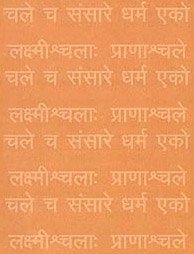Svabhavika, Svābhāvikā, Sva-bhavika, Svābhāvika: 18 definitions
Introduction:
Svabhavika means something in Buddhism, Pali, Hinduism, Sanskrit, Marathi, Hindi. If you want to know the exact meaning, history, etymology or English translation of this term then check out the descriptions on this page. Add your comment or reference to a book if you want to contribute to this summary article.
Alternative spellings of this word include Swabhavik.
Images (photo gallery)
In Hinduism
Natyashastra (theatrics and dramaturgy)
Source: Wisdom Library: Nāṭya-śāstra1a) Svābhāvikā (स्वाभाविका, “natural”) refers to a specific gesture (āṅgika) made with the nose (nāsā), according to the Nāṭyaśāstra chapter 8. These gestures form a part of the histrionic representation (abhinaya).
1b) Svābhāvikā also refers to a specific “color of the face” which form part of the histrionic representation (abhinaya), according to the Nāṭyaśāstra chapter 8. According to its instructions, this facial color should be use when “in a natural and indifferent (mood)”. (Instructions): lobes in the natural nose. (Uses): in the remaining conditions.
1c) Svābhāvikā (स्वाभाविका, “natural”) refers to the “natural grace” of women, according to the Nāṭyaśāstra chapter 24. It is also known ny the name Svabhāvaja or Sahaja. The natural grace is one of the three aspects of ‘graces’ (alaṃkāra) which forms the support of sentiments (rasa) in drama. These terms are defined according to the science of sāmānyābhinaya, or “harmonious representation”.
There are ten ‘natural graces’ of women (svābhāvika) defined:
- līlā (sportive mimicry),
- vilāsa (amorous gesture),
- vicchitti (dishabille),
- vibhrama (confusion),
- kilakiñcita (hysterical mood),
- moṭṭāyita (manifestation of affection),
- kuṭṭamita (pretended anger),
- bibboka (affected coldness),
- lalita (lolling),
- vihṛta (want of response),
Svābhāvika (स्वाभाविक) or Svābhāvikagati refers to one of the various Gatis (“way of walking”) (in Indian Dramas), according to the Viṣṇudharmottarapurāṇa, an ancient Sanskrit text which (being encyclopedic in nature) deals with a variety of cultural topics such as arts, architecture, music, grammar and astronomy.—The word svābhāvika means natural. So, the term svābhāvika-gati denotes natural gait. According to the Viṣṇudharmottarapurāṇa, in natural gait the knees are lifted up to waist.

Natyashastra (नाट्यशास्त्र, nāṭyaśāstra) refers to both the ancient Indian tradition (shastra) of performing arts, (natya—theatrics, drama, dance, music), as well as the name of a Sanskrit work dealing with these subjects. It also teaches the rules for composing Dramatic plays (nataka), construction and performance of Theater, and Poetic works (kavya).
Samkhya (school of philosophy)
Source: Shodhganga: Prakrti and purusa in Samkhyakarika an analytical reviewSvābhāvika (स्वाभाविक, “natural”) refers to a type of saṃyoga (lit. ‘contact’), a relation between prakṛti and puruṣa.—The contact produced by the innate (or natural) relation between two entities is called svābhāvika-saṃyoga. For example, the contact produced between the fire and its heat.

Samkhya (सांख्य, Sāṃkhya) is a dualistic school of Hindu philosophy (astika) and is closeley related to the Yoga school. Samkhya philosophy accepts three pramanas (‘proofs’) only as valid means of gaining knowledge. Another important concept is their theory of evolution, revolving around prakriti (matter) and purusha (consciousness).
Vyakarana (Sanskrit grammar)
Source: Wikisource: A dictionary of Sanskrit grammarSvābhāvika (स्वाभाविक).—Natural, unartificial; the word is used frequently in connection with the capacity of denotation which words naturally possess; cf. अभिधानं पुनः स्वाभाविकम् (abhidhānaṃ punaḥ svābhāvikam) P. I. 2.64 Vart. 36.

Vyakarana (व्याकरण, vyākaraṇa) refers to Sanskrit grammar and represents one of the six additional sciences (vedanga) to be studied along with the Vedas. Vyakarana concerns itself with the rules of Sanskrit grammar and linguistic analysis in order to establish the correct context of words and sentences.
Purana and Itihasa (epic history)
Source: archive.org: Shiva Purana - English TranslationSvābhāvika (स्वाभाविक) refers to the “natural dress and features (of Śiva)”, according to the Śivapurāṇa 2.3.39 (“The gods arrive at Kailāsa”).—Accordingly, as the guests arrived for Śiva’s marriage: “[...] The seven Mothers performed the rites of bedecking Śiva in a fitting manner very joyously. Even the very natural dress and features (svābhāvika) of Śiva assumed the work of ornamentation, O excellent sage, at the will of lord Siva. The moon took the place of the crown. The third eye became the beautiful ornament on the forehead. [...]”.

The Purana (पुराण, purāṇas) refers to Sanskrit literature preserving ancient India’s vast cultural history, including historical legends, religious ceremonies, various arts and sciences. The eighteen mahapuranas total over 400,000 shlokas (metrical couplets) and date to at least several centuries BCE.
In Buddhism
General definition (in Buddhism)
Source: Wisdom Library: BuddhismSvābhāvika (स्वाभाविक) is the name for a popular Buddhist sect in Nepal and China.
Languages of India and abroad
Marathi-English dictionary
Source: DDSA: The Molesworth Marathi and English Dictionarysvabhāvika (स्वभाविक) [or वीक, vīka].—a (Common corruption of svābhā- vika) Natural or native; pertaining naturally and essentially. 2 Used as ad Simply, merely, carelessly, inadvertently; without any particular purpose or thought: also of itself or its own accord; as a matter of course; without any effort, working, or act from an external cause.
--- OR ---
svābhāvika (स्वाभाविक).—a (S svabhāva) Natural, native, proper; pertaining naturally, constitutionally, or essentially. 2 Used as ad Simply, spontaneously, of itself or its own accord, without any apparent cause: also idly, merely, carelessly, unwittingly, without advertence of mind or any particular purpose proposed.
Source: DDSA: The Aryabhusan school dictionary, Marathi-Englishsvabhāvika (स्वभाविक) [-vīka, -वीक].—a Natural. ad Simply.
--- OR ---
svābhāvika (स्वाभाविक).—a Natural. ad Simply.
Marathi is an Indo-European language having over 70 million native speakers people in (predominantly) Maharashtra India. Marathi, like many other Indo-Aryan languages, evolved from early forms of Prakrit, which itself is a subset of Sanskrit, one of the most ancient languages of the world.
Sanskrit dictionary
Source: DDSA: The practical Sanskrit-English dictionarySvābhāvika (स्वाभाविक).—a. (-kī f.) [स्वभावादागतः ढञ् (svabhāvādāgataḥ ḍhañ)] Belonging to one's own nature, innate, inherent, peculiar, natural; स्वाभाविकं विनीतत्वं तेषां विनयकर्मणा । मुमूर्च्छ सहजं तेजो हविषेव हविर्भुजाम् (svābhāvikaṃ vinītatvaṃ teṣāṃ vinayakarmaṇā | mumūrccha sahajaṃ tejo haviṣeva havirbhujām) R.1.79;5.69; Kumārasambhava 6.71.
-kāḥ m. pl. A sect of Buddhists who accounted for all things by the laws of nature.
Source: Cologne Digital Sanskrit Dictionaries: Shabda-Sagara Sanskrit-English DictionarySvābhāvika (स्वाभाविक).—mfn.
(-kaḥ-kī-kaṃ) Natural, peculiar, inherent. m. Plu.
(-kāḥ) A sect of Bud'dhists who accounted for all things by the law of nature. E. svabhāva natural property or nature, ṭhak aff.
Source: Cologne Digital Sanskrit Dictionaries: Benfey Sanskrit-English DictionarySvābhāvika (स्वाभाविक).—i. e. sva-bhāva + ika, adj. Being by one’s own nature, inherent, natural, [Mānavadharmaśāstra] 3, 46; [Pañcatantra] 66, 10; 110, 21.
Source: Cologne Digital Sanskrit Dictionaries: Cappeller Sanskrit-English DictionarySvābhāvika (स्वाभाविक).—[feminine] ī belonging to one’s own nature, natural, peculiar, inherent.
Source: Cologne Digital Sanskrit Dictionaries: Monier-Williams Sanskrit-English Dictionary1) Svābhāvika (स्वाभाविक):—mf(ī)n. ([from] svabhāva) belonging to or arising from one’s own nature, natural, native, spontaneous, original, peculiar, inherent (-tva n.), [Upaniṣad; Mahābhārata etc.]
2) m. [plural] Name of a Buddhistic school (cf. Buddhac. ix, 48; 51).
Source: Cologne Digital Sanskrit Dictionaries: Yates Sanskrit-English DictionarySvābhāvika (स्वाभाविक):—[(kaḥ-kī-kaṃ) a.] Natural, peculiar, inherent.
Source: DDSA: Paia-sadda-mahannavo; a comprehensive Prakrit Hindi dictionary (S)Svābhāvika (स्वाभाविक) in the Sanskrit language is related to the Prakrit word: Sāhāvia.
[Sanskrit to German]
Sanskrit, also spelled संस्कृतम् (saṃskṛtam), is an ancient language of India commonly seen as the grandmother of the Indo-European language family (even English!). Closely allied with Prakrit and Pali, Sanskrit is more exhaustive in both grammar and terms and has the most extensive collection of literature in the world, greatly surpassing its sister-languages Greek and Latin.
Hindi dictionary
Source: DDSA: A practical Hindi-English dictionarySvābhāvika (स्वाभाविक) [Also spelled swabhavik]:—(a) natural; innate, inherent, inborn; ~[tā] naturality, inartificiality.
...
Kannada-English dictionary
Source: Alar: Kannada-English corpusSvābhāvika (ಸ್ವಾಭಾವಿಕ):—
1) [adjective] present by virtue of nature; innate; not acquired; natural.
2) [adjective] having certain qualities, abilities, etc. innately; natural.
3) [adjective] normal or usual; in the ordinary course of events; natural.
4) [adjective] customarily expected or accepted; natural.
5) [adjective] free from affectation or artificiality.
--- OR ---
Svābhāvika (ಸ್ವಾಭಾವಿಕ):—[noun] that which is natural.
Kannada is a Dravidian language (as opposed to the Indo-European language family) mainly spoken in the southwestern region of India.
See also (Relevant definitions)
Partial matches: Bhavika, Shva.
Starts with: Svabhavika-nivasa, Svabhavika-vriddhi, Svabhavikagati, Svabhavikata, Svabhavikate.
Ends with: Asvabhavika.
Full-text (+34): Svabhaviki, Svapavikam, Cuvapavikam, Svabhava, Mukharaga, Vinitatva, Pravikatthate, Svabhaviketara, Sahavia, Pratitika, Arthabhidhana, Swabhavik, Svabhavya, Svabhavikagati, Aishvarika, Svabhavaja, Nathavinem, Nasa, Svaja, Paribhashika.
Relevant text
Search found 36 books and stories containing Svabhavika, Sva-bhavika, Svā-bhāvika, Svā-bhāvikā, Svābhāvikā, Svābhāvika, Svabhāvika; (plurals include: Svabhavikas, bhavikas, bhāvikas, bhāvikās, Svābhāvikās, Svābhāvikas, Svabhāvikas). You can also click to the full overview containing English textual excerpts. Below are direct links for the most relevant articles:
Manusmriti with the Commentary of Medhatithi (by Ganganatha Jha)
Verse 3.46 < [Section V - Duties of Marital Life]
Mandukya Upanishad (Madhva commentary) (by Srisa Chandra Vasu)
Karika verse 2.10 < [Chapter 2 - Second Khanda]
Bhakti-rasamrta-sindhu (by Śrīla Rūpa Gosvāmī)
Verse 1.2.185 < [Part 2 - Devotional Service in Practice (sādhana-bhakti)]
Verse 1.2.184 < [Part 2 - Devotional Service in Practice (sādhana-bhakti)]
Vakyapadiya of Bhartrihari (by K. A. Subramania Iyer)
Verse 3.14.196 < [Book 3 - Pada-kāṇḍa (14): Vṛtti-samuddeśa (On Ccomplex Formation)]
Verse 2.407 < [Book 2 - Vākya-kāṇḍa]
Verse 3.4.1-2 < [Book 3 - Pada-kāṇḍa (4): Dravyalakṣaṇa-samuddeśa (On Substance)]
The gods of northern Buddhism (by Alice Getty)
Cidgaganacandrika (study) (by S. Mahalakshmi)
Verse 262 [Kāli’s greatness revealed] < [Chapter 4 - Fourth Vimarśa]
Related products


